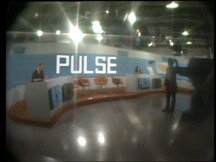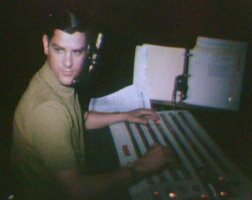ANCHORS AWAY!
Lesley Schissell and Ron Meyer were reporter/anchors for WTVT. Ron started in 1967 and Lesley joined the station in 1972. Both asked the station for air-checks over a period of years.
In the summer of 2004, BIG 13 learned from Lesley and Ron that they had retained some quad tapes and would make them available to BIG 13's web master Mike Clark for duplication. Lesley sent six reels while Ron shipped nine. Only one of the reels was still in its own cardboard box.
Mike took the tapes to one of Los Angeles' top firms for video restoration: Research Video in North Hollywood. Paul Surratt is the owner of Research Video and has spent the last decade restoring quad tapes. Some of his clients have included Dinah Shore, Perry Como, Tennessee Ernie Ford, as well as NBC, CBS, and ABC.
The WTVT tapes were examined by Surratt and his associate Bill DiCicco, who was confident that the quads would play back with a minimum threat of head clogging.
Research Video's Bill DiCicco with an Ampex VTR
A 1970's era Ampex VR-2000 (the standard VTR used at WTVT) is situated near a rack of newer Betacam recorders at the Research facility. The older quad tapes are played back and relayed to the Betacams for the new master recording. One treats the Ampex machine with respect in preparation for dubbing the spot reels.
| DiCicco explained that the heads and guides of the Ampex must be cleaned before and after every tape. Using a lintless piece of white cloth soaked with Isopropyl Alcohol, DiCicco carefully wipes the audio and video heads and the guides before putting one of the Schissell reels on the source hub. |
DiCicco spoke of the many times that older quad tapes had clogged the machine, requiring a head clean. It once took him nine hours to transfer a thirty-minute reel due to the excessive head clogs!
|
The Ampex machine made the old familiar whine as the heads were activated and revved up to speed. A green waveform monitor and series of oscilloscopes told DiCicco what mechanical and electrical adjustments were necessary for each reel.
|
A picture with uneven stripes of color is called 'banding', a result of the quad format. Four video heads are used to record the entire television picture, and each head must be in alignment for a steady picture and uniform color.
Color variations in the picture above are called 'banding'
As the video tape passed the setup color bars, DiCicco tweaked several control knobs and switches to reduce banding and maximize the signal coming off of the tape. The first images came through on the color monitorPulse anchor Paul Hoffman introducing Schissell as the new Sunday evening news anchor. The picture was rock-solid and the colors were true to the day the tape was made. The WTVT engineers had done a good job making Schissell's air-check, and the results were paying off 30 years later.

Success! Lesley Schissell anchors an early
1970s edition of Pulse
Tape after tape was loaded onto the vintage VTR and successfully played and copied onto Betacam stock. Only one tape caused some clogging, and that was easily dealt with by cleaning the head. We were extremely lucky.
 |
|
 |
ABOVE:
1972 Pulse Newscast/Director Jim Benedict/Anchor Hugh Smith
Through the courtesy of Meyer's and Schissell's videos, a window opened up to allow a view 30 years into Channel 13's past. It was a clear, colorful window showing the old Pulse set, some 16mm film shot around the station, an interview with then-Governor Claude Kirk, some early color tape of Hugh Smith, and other rare gems.
The Meyer/Schissell videos will be shared with other WTVT employees at the Channel 13 Employee Reunion coming up on April 2, 2005. Thanks to Lesley and Ron, the attendees are in for an extra special treat.
Special Thanks to Paul Surratt and Bill DiCicco of Research Video
TO RETURN TO MAIN MENU CLICK HERE
